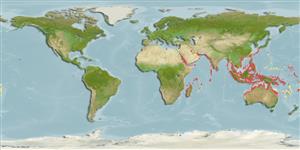Common names from other countries
Élasmobranches (requins et raies) (sharks and rays) >
Myliobatiformes (Stingrays) >
Dasyatidae (Stingrays) > Neotrygoninae
Etymology: Taeniura: Latin, taenia = stripe + Greek, oura = tail (Ref. 45335).
Environment: milieu / climate zone / depth range / distribution range
Écologie
marin récifal; profondeur 0 - 20 m (Ref. 9840). Tropical; 32°N - 30°S, 32°E - 177°W
Indo-West Pacific: Persian Gulf (Ref.80050); Red Sea and East Africa to the Solomon Islands, north to southern Japan (Ref. 9710), south to northern Australia.
Length at first maturity / Taille / Poids / Âge
Maturity: Lm 20.3, range 21 - ? cm
Max length : 35.0 cm WD mâle / non sexé; (Ref. 58048)
A colorful stingray with large bright blue spots on an oval, elongated disc and with blue side-stripes along the tail; snout rounded and angular, disc with broadly rounded outer corners, and tail stout, tapering and less than twice body length when intact, with a broad lower caudal finfold reaching the tail tip; disc with no large thorns but with small, flat denticles along midback (in adults); usually 1 medium-sized sting on tail further behind base than in most stingrays (Ref. 5578). Grey-brown to yellow, olive-green or reddish brown dorsally, white ventrally (Ref. 5578).
Occurs around coral reefs (Ref. 6871, 58534). Migrates in groups into shallow sandy areas during the rising tide to feed on mollusks, worms, shrimps, and crabs; disperses on falling tide to seek shelter in caves and under ledges (Ref. 6871). Rarely found buried under the sand (Ref. 12951). Ovoviviparous (Ref. 50449). Small specimens are popular among marine aquarists (Ref. 5578). Does not do well in aquariums (Ref. 12951). Maximum length about 70 cm TL (Ref. 30573). Reports of specimens reaching 240 cm TL are probably inaccurate (Ref. 6871). Commonly caught by fisheries operating over shallow coral reefs and probably adversely affected by dynamite fishing. Utilized widely for its meat (Ref.58048). Minimum depth reported taken from Ref. 86942.
Life cycle and mating behavior
Maturities | Reproduction | Spawnings | Egg(s) | Fecundities | Larves
Exhibit ovoviparity (aplacental viviparity), with embryos feeding initially on yolk, then receiving additional nourishment from the mother by indirect absorption of uterine fluid enriched with mucus, fat or protein through specialised structures (Ref. 50449). Distinct pairing with embrace (Ref. 205). Distinct pairing with embrace (Ref. 205). Bears up to 7 young (Ref. 5578, 12951).
Randall, J.E., G.R. Allen and R.C. Steene, 1990. Fishes of the Great Barrier Reef and Coral Sea. University of Hawaii Press, Honolulu, Hawaii. 506 p. (Ref. 2334)
Statut dans la liste rouge de l'IUCN (Ref. 130435)
CITES (Ref. 128078)
Not Evaluated
Utilisations par l'homme
Pêcheries: commercial; pêche sportive: oui; Aquarium: Commercial
Outils
Articles particuliers
Télécharger en XML
Sources Internet
Estimates based on models
Preferred temperature (Ref.
115969): 25.5 - 29.3, mean 28.6 (based on 3112 cells).
Phylogenetic diversity index (Ref.
82804): PD
50 = 0.6250 [Uniqueness, from 0.5 = low to 2.0 = high].
Bayesian length-weight: a=0.01096 (0.00342 - 0.03513), b=3.11 (2.86 - 3.36), in cm Total Length, based on LWR estimates for this (Sub)family-body shape (Ref.
93245).
Niveau trophique (Ref.
69278): 3.8 ±0.45 se; based on food items.
Résilience (Ref.
120179): Très faible, temps minimum de doublement de population supérieur à 14 ans (Fec=7).
Fishing Vulnerability (Ref.
59153): Very high vulnerability (90 of 100).
